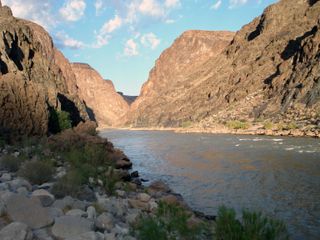
64-Million-Year Controversy: Grand Canyon Age Debated

Since two researchers suggested last year that the Grand Canyon was carved 70 million years ago (much older than the consensus of 6 million years), a rousing debate over the canyon's true age has played out at scientific meetings, through email, and now, in the pages of a respected journal.
In today's (April 11) issue of the journal Science, several geologists who've spent years roaming the Southwest's red rocks and cliffs respond to the original old Grand Canyon study, published in November 2012 in Science. Their critique hinges on two primary points: Assessing the laboratory techniques that revealed when the Grand Canyon's deepest rocks were brought to the surface, and rock evidence that points to a young Colorado River, the waterway now filling the gorge.
"If there was a canyon where the present canyon is, it would have left some evidence at the mouth of the canyon at the Grand Wash trough," said Ivo Lucchitta, an emeritus geologist with the U.S. Geological Survey in Arizona and one of the technical comment authors. The Grand Wash trough, a basin in the Lake Mead region west of the Grand Canyon, contains a thick pile of gravel, limestone and volcanic rocks that pin down the 6-million-year age of the Colorado River. Geologic evidence for canyon-carving in the present-day Grand Canyon before 6 million years is lacking, Lucchita and his co-authors said.
In a point-counterpoint that's common in Science and other academic journals, the lead author of the initial study, Rebecca Flowers, said the ancient Southwest was an even more arid environment, with different topography than today, which meant older rivers likely left behind less sediment than today's Colorado River. Older materials could also have eroded away when the Colorado River punched through, said Flowers, a geologist at the University of Colorado, Boulder. "The absence of obvious detritus in the Grand Wash trough does not preclude the ancient Grand Canyon," she told OurAmazingPlanet.
But the case for Flowers' ancient canyon primarily rests on what are called thermochronologic dating techniques that reveal when rock was exposed near the surface. Tiny mineral grains indicated the western Grand Canyon was carved 70 million years ago to within about 1,000 feet (300 meters) of its current depth, and the eastern Grand Canyon was cut more shallowly by about 55 million years ago. [Grand Canyon in Pictures]

Geologists led by Karl Karlstrom of the University of New Mexico in Albuquerque, lead author of one of the critiques, said their mineral samples support a young canyon, but Flowers said the opposing side's data could be interpreted in favor of an old canyon too. The argument rests on how the different groups model the escape of elements such as helium, uranium and thorium from the mineral apatite. The apatite measurements point to cooling of the rocks as layers of overlying sediment were removed by erosion.
"I think we have a data set that really provides for ancient canyon carving, and I agree this is going to continue to be controversial," Flowers said. One of the world's natural wonders, though the spectacular setting lays out nearly half of Earth's history in a colorful layer cake of rocks, the age of the Grand Canyon has been debated for a century.
Sign up for the Live Science daily newsletter now
Get the world’s most fascinating discoveries delivered straight to your inbox.
Though the jigsaw puzzle of Colorado Plateau geology has many missing pieces, removed by erosion or tectonics, scientists do believe a consensus on the Grand Canyon's history will emerge.
"It's very complicated, but we have some hope that in the not-to-distant future we may be able to approach a solution," Lucchitta said.
Email Becky Oskin or follow her @beckyoskin. Follow us @OAPlanet, Facebook or Google+. Original article on LiveScience's OurAmazingPlanet.













